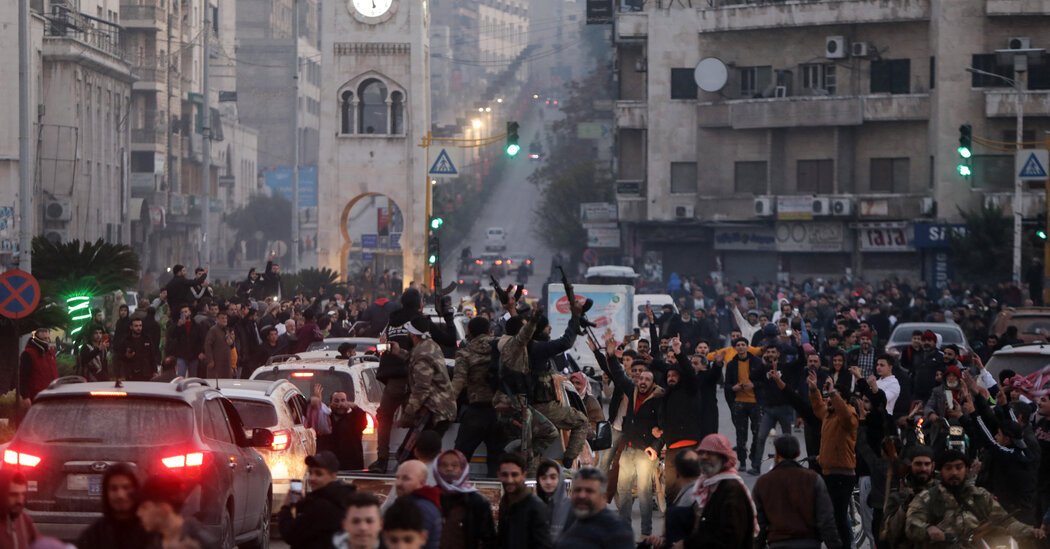Advertisement
Geopolitics can often be best understood as an equilibrium — of expectations, of strength and of capabilities. When something upsets that balance, it can lead to chaos.
That’s been a frequent theme of this column over the last few months, and the examples keep adding up. It’s now clear that a number of “frozen conflicts” — wars that had become stuck in stalemates for years because neither side was strong enough to make substantial gains — have suddenly heated up.
Five years ago, there were frozen conflicts in eastern Ukraine, Gaza and Lebanon. All have since flared into open conflicts that shattered the status quos.
These conflicts are all different, with their own separate causes. But they also share many of the same players, which means that ripple effects of events like Russia’s invasion of Ukraine and Hamas’s attack on Israel are now being felt around the world.
The most notable recent example is Syria, where the frozen civil war reignited in dramatic fashion when the rebel group Hayat Tahrir al-Sham launched a surprise attack last week, capturing a large swath of territory, as seen in this map by my colleague Samuel Granados:
Image
The rebels have taken Aleppo, Syria’s second-largest city, and Hama, a longtime government stronghold. They are pushing south toward the major city of Homs, and could even threaten the capital of Damascus.
What upended the equilibrium in Syria? And does it share any factors with other frozen conflicts that have thawed, with bloody results, in the last few years?
Distant ripples lead to big changes
First, let’s define what we’re talking about here. Conflicts freeze because they come into equilibrium, with no side strong enough to win or weak enough to lose. Violence may not cease entirely, with isolated incidents of airstrikes and other clashes, but the front lines and strategic calculus do not change much.
Any material change in global affairs — even far from the conflict itself — can throw things off balance, and turn protracted stalemates into all-out war. The repercussions can rapidly ricochet around the globe.
Russia and Ukraine were arguably in a frozen conflict before 2022: Russia had annexed Crimea and backed separatists in Eastern Ukraine, who had fought to a standstill against the Ukrainian military. That freeze ended when Russia invaded Ukraine — with ripples that are still being felt around the world.
When Hamas carried out its bloody attack on Israel on Oct. 7, 2023, that not only triggered a devastating war with Israel, but also led to yet another war between Israel and Hezbollah in Lebanon. It brought the covert war between Israel and Iran — which backs Hamas and Hezbollah — out into the open. And it indirectly contributed to the rebel offensive in Syria, because the Assad government also relied on support from Hezbollah and Iran.
Image
In Syria, changes to the equilibrium have played out slowly and by degrees — until last week, when the Hayat Tahrir al-Sham rebels began their lightning offensive.
Russia has supported the government of Bashar al-Assad since 2015, and maintains a major military presence in Syria.
But since its invasion of Ukraine, Russia has withdrawn a lot of its forces, including special operations soldiers that were supporting the Syrian army, said Nicole Grajewski, a researcher at the Harvard Kennedy School and the author of the forthcoming book “Russia and Iran: Partners in Defiance from Syria to Ukraine.” That drawdown was compounded by the recent weakening of Hezbollah, the Iranian-backed militant group, which had provided a lot of the ground support for the Russian air campaigns in Syria, Grajewski said.
Over the last few months, Israel has wiped out much of Hezbollah’s leadership and severely degraded its military capability in Lebanon — a war triggered by the Oct. 7, 2023 attacks led by Hamas, an ally of Hezbollah within Iran’s ‘Axis of Resistance.’ Israel also targeted Hezbollah forces in Syria, leaving them weaker there.
Last week, when Hayat Tahrir al-Sham began its offensive, Syrian defenses collapsed immediately, allowing the rebel group to seize the cities of Aleppo and Hama in a matter of days.
In the background, a deeper shift
But there is also another shift, harder to measure but perhaps ultimately more important, that may have played a role in thawing these conflicts: the weakening of longstanding norms of the post-Cold War order.
Since World War II, and particularly since the end of the Cold War, there have been strong international norms discouraging the use of military force, especially on foreign soil, and of respect for the borders of sovereign states.
There are many exceptions, including the U.S. invasion of Iraq in 2003. But there is increasing evidence that those norms have started to crumble, and the world has changed yet again.
Ukraine is an instructive example. When Russia annexed Crimea in 2014, it hid the fact that the armed men who seized the territory were Russian troops, a subterfuge that paid lip service to the prevailing norms even if it fooled no one. By 2022, there was no such illusion: The Russian military openly invaded and attempted to annex a sovereign state.
“There’s clearly no longer a feeling of deterrence,” said Thomas de Waal, a senior fellow at Carnegie Europe who co-authored a book on frozen conflicts. “So I think we’re living in a more Darwinian world.”
Advertisement
